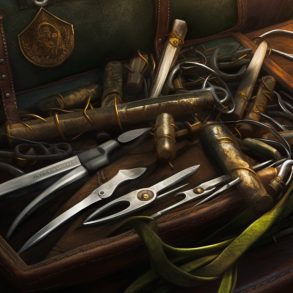This slender blade has long been associated with rakish duelists, swashbucklers, and haughty nobles. In this article, we’ll take a look at how rapiers work in 5E and interesting ways to use them.
How rapiers work
A rapier is a martial weapon that costs 25 GP and does 1d8 piercing damage on a hit. It has the finesse property, meaning that you can choose to use either your Strength or Dexterity modifier for the attack and damage rolls. The finesse property is also essential to a Rogue getting Sneak Attack with a melee weapon.
The rapier is available from level 1 to Barbarians, Bards, Fighters, Paladins, Rangers, and Rogues. If you would like to use a rapier with any other classes you can gain the proficiency from multiclassing, the Weapon Master feat, and a selection of subclasses, such as the Artificer’s Battle Smith.
One fancy lookin’ sword
If you’re enamored with the idea of primarily, or solely, using a rapier for your next PC you might be wondering which classes get the most out of it and how you can make it better. Fear not, here are a couple of examples to get your creative juices flowing:
Battle Smith – These Artificers gain proficiency with rapiers from their subclass and thanks to their Infuse Item feature they can enchant one themselves. Both a normal +X enchantment and a defensive flash of light are on offer, although the latter requires you to be at least level 6 first.
Bards – These musical spellcasters lack a medium or high-damage cantrip option, luckily they have proficiency with the rapier and can have one from their starting equipment. This will give you a reliable at-will damage option into Tier 2 when needed, you can even improve it by taking the College of Swords or College of Valor, though the former is best in this regard.
Rogues – Perhaps the most iconic users of this weapon, the rapier is the only finesse weapon to offer Rogues a d8 damage die, meaning it’s the highest damage option for one-handed Rogues whilst still getting Sneak Attack.
Defensive Duelist – This feat allows you to add your proficiency bonus to your AC as a reaction, as long as you’re holding a finesse weapon. This is both useful to keep you alive and really fleshes out the iconic imagery of a skilled duelist using a rapier.
Booming Blade and Green Flame Blade – Both of these cantrips allow you to add additional damage and damage riders to a weapon attack, combined with a rapier these make for a powerful option for classes lacking Extra Attack. Alternatively, the Bladesinger Wizard subclass can use one of these cantrips and attack normally with their altered version of Extra Attack.
Congratulations on finding the information you need to look stylish in your upcoming duel! If you’re a new player learning the game, then check out our how to play DnD 5E section, or if you’re here because you’re considering a rapier-using Rogue, then check out our Rogue 5E guide. Best of luck in your future battles, and may your strikes be accurate and your parries well-executed.
What is a rapier in DnD 5E?
A rapier is a type of finesse weapon in the DnD 5E role-playing game.
What are the benefits of using a rapier in DnD 5E?
The finesse trait of a rapier allows you to use either Strength or Dexterity, making it valuable to any Dex-based builds. It also allows a Rogue to trigger their Sneak Attack feature.
Can a character use a rapier with two-weapon fighting in DnD 5E?
Yes, but only if you take the Dual Wielder feat. You can’t use a rapier with two-weapon fighting without this feat as a rapier is not a light weapon.
What are the drawbacks of using a rapier in DnD 5E?
The main drawback of using a rapier in DnD 5E is that it is not as damaging as other weapons, such as heavy weapons or two-handed weapons.






